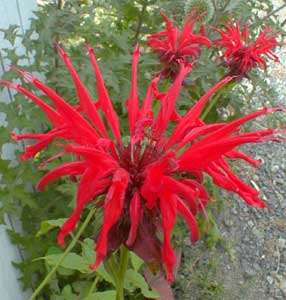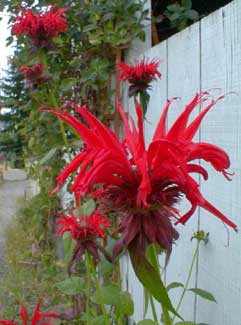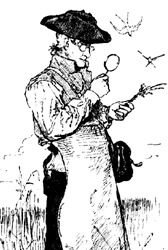
Jacob Kline's
Scarlet Bee Balm
"Once, Flower, you were beautiful, sweet,
Both the bees & the butterflies came,
Now no one seems to care,
Beauty fades. Romance becomes shame."
-"Falling Flowers"
by Chun Park Lum,
1927
by Chun Park Lum,
1927
The pure red 'Jacob Kline' beebalm is growing along the alley-side of the garage next to purple 'Marshall's Delight' beebalm. 'Jacob Kline's' is the taller of the two beebalms. It also has larger blossoms than does 'Marshall's Delight' & begins blooming two to four weeks earlier.
It is regarded as the best of the red beebalms. Red is the favorite color of hummingbirds, who already like bee balms a great deal, & most apt to be drawn to this one.
This variety is named for the chap who developed it for large brilliantly red especially long-lasting flowers &, in particular, for resistance to powdery mildew, which is the bane of bee balms. 'Jacob Kline' is said to be the most resistant of all the reds, but frankly no variety is apt indefinitely to avoid at least a mild affliction, if only in autumn when it is getting ready to die back anyway.
If mildew does appears in autumn, this is fairly normal for fading foliage & no great worry. But to limit the number of spoors that overwinter, infected beebalms should be shorn to the ground & all infected leaves & stems discarded rather than composted.
 On the other hand, if powdery mildew occurs in summer, when the beebalms are shorn down & infected parts discarded, the clumps can be expected to grow back so swiftly there'll be one more good bloom-period for early autumn. While the leaves are returning & fluffing out, occasional sprays of milk diluted with five parts water will help keep mildew from returning. Dilute milk is not only an organic treatment for powdery mildew, it happens also to work far better than do fungicides, which unlike the milk treatment has the sorry habit of killing beneficial funguses too.
On the other hand, if powdery mildew occurs in summer, when the beebalms are shorn down & infected parts discarded, the clumps can be expected to grow back so swiftly there'll be one more good bloom-period for early autumn. While the leaves are returning & fluffing out, occasional sprays of milk diluted with five parts water will help keep mildew from returning. Dilute milk is not only an organic treatment for powdery mildew, it happens also to work far better than do fungicides, which unlike the milk treatment has the sorry habit of killing beneficial funguses too.'Jacob Kline' has lost none of the species' aggression. Its strong desire to spread & spread has to be taken into consideration. We planted our beebalm patches between garage wall & alley, where it cannot go anywhere it isn't wanted. 'Marshall's Delight' has never spread all that much, but 'Jacob Kline' has become a very big gorgeous clump.
This cultivar will self-seed & can do so willfully, but does not grow true to the parent. Propagation is therefore by division. Since the clump increases in size rather rapidly, there will be ample opportunity to divide it into multiple plants.
Clumps will become unsightly in the middle of each clump the third or fourth year & should be dug up, divided, & replanted, giving the extra plants to all your buddies. For extensive patches that are too difficult to dig up entirely, just dig out & compost the homely bits; the plant will soon spread back into the cleared spots.
This clumping perennial blooms June through August or later, until it experiences a good frost which will start it dying back for winter. Compact leaf growth & flower heads rise to a height of three feet or a bit more, & flower stems will rise to four or five feet.
It prefers consistently moist well-draining soil. Drought-tolerant once established, such stresses do increase the possibility of powdery mildew at least come autumn, & shortens the lengthy bloom time.
In a gardening newsgroup, a gardener posted her observation that bees were all over her perennials, including her monardas, except for 'Jacob Kline.' Other gardeners chimed in that they also had noticed bees skipping past 'Jacob Kline.' This started me watching mine more carefully, & I perceived no lack of bees & other pollinators in love with this cultivar. Nevertheless, the observation may be true, as some bees may have trouble reaching to the bottom of the unusually long thin tubes that make up the larger-than-average flowerheads of 'Jacob Kline,' making it more frustrating for any bee attempting to reach the nectar.
Further, in controlled studies it has been discovered that bees take longer to find bright red flowers than it takes them tofind violet or blue flowers. Thus if bright red 'Jacob Kline' & purple 'Marshall's Delight' are grown side by side, the bees will more quickly reach 'Marshall's Delight.'
 Bee balm's alternate name "Oswego Tea" was bestowed upon it by pioneer botanist John Bartram (1699-1777) who observed Oswego Indians using it for tea. As a tea, the odor & flavor is a mix of citrus & mint, well worth harvesting from one's garden for this purpose.
Bee balm's alternate name "Oswego Tea" was bestowed upon it by pioneer botanist John Bartram (1699-1777) who observed Oswego Indians using it for tea. As a tea, the odor & flavor is a mix of citrus & mint, well worth harvesting from one's garden for this purpose.Bartram, a Quaker farmer, is shown in a contemporary portrait here at the left. He was the first important botanist born in North America, a native of Pennsylvania. He collected plants throughout the Colonies, & is now known as "The Father of American Botany."
He was an inveterate traveller who penetrated into dangerous wildernesses gathering seeds & specimens for his botanical garden at Kingsessing on the Schuylkill River, which he founded in 1728. His home & a considerable portion of his gardens survive to the modern era as Philadelphia's Historic Bartram Gardens.
Although Bartram never visited England, King George III appointed him Royal Botanist to the king. He sent seeds of wild M. didyma to England in 1744 & it bloomed the very next year. By 1760 it was being offered commercially. Select cultivars & hybrids were thereafter inevitable, so this North American native has been long gardened throughout Europe.